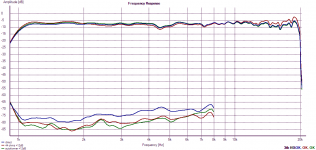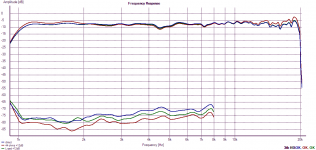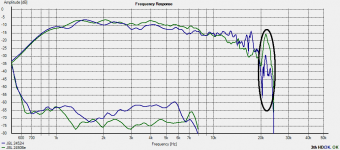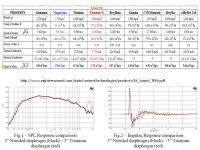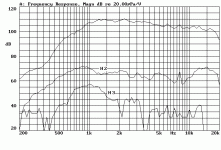Quite true, but in that case the phasing plugs are almost identical. The 2452 has a shorter phase plug in fact, but from the measurements I have made the breakups behavior is identical with a 2450SL+Ti ribbed diaphragm, with the same two big modes at ~12khz and ~17khz (and a lot of smaller ones around that of course)In case of compression driver it is very difficult to know what is diaphragm breakup and what is cancelation of HF from phase plug /from measurement/. The cancelation is different for different phragm because of different breakup.
Intersting
Have you compared with an Lpad or an autoformer?
I have compared only with and without the 33ohm series resistor. The reason behind the current drive is to do the V/I conversion somewhere else than in the voice coil (because of the nonlinear electric motor forces in the VC). Distortion examples - Current-Drive - The Natural Way of Loudspeaker Operation
Yes I have measured very interesting distortion reduction with a similar approach on some of my drivers.
But then with a very high sensitivity transducer like a CD the distortion/noise of the amp itself will also come into play. So comparing what you get with a series resistor to what you get with a Lpad or an autoformer (with similar gain reduction, and EQ to compensate the effect of the current drive on the frequency curve relative to impedance) would be interesting as well.
Here are some measurements I did some time ago (I think it was the 2450SL+Truextent, so it is still on topic ), with no EQ.
), with no EQ.
I had to use two grphas because HOLM only allows for 3 curves on a graph.
As you can see it looks like current drive in itself does not give lower distortion than a simple gain reduction with an autoformer on the compression driver (the amplifier seems to like the higher impedance...)
I have had much better results on my midbass drivers (up to 15dB 3rd distortion reduction compared to direct, Lpad, or autoformer).
But then with a very high sensitivity transducer like a CD the distortion/noise of the amp itself will also come into play. So comparing what you get with a series resistor to what you get with a Lpad or an autoformer (with similar gain reduction, and EQ to compensate the effect of the current drive on the frequency curve relative to impedance) would be interesting as well.
Here are some measurements I did some time ago (I think it was the 2450SL+Truextent, so it is still on topic
I had to use two grphas because HOLM only allows for 3 curves on a graph.
As you can see it looks like current drive in itself does not give lower distortion than a simple gain reduction with an autoformer on the compression driver (the amplifier seems to like the higher impedance...)
I have had much better results on my midbass drivers (up to 15dB 3rd distortion reduction compared to direct, Lpad, or autoformer).
Attachments
Last edited:
Interesting, thanks for sharing that. I could barely measure any difference in THD or IMD, but listening test proved series resistor current driving better than direct driving. It's clearly easier to the ears even though the upper end gains couple dB's more sparkle. With better resistor (I tested with 50w wirewound) the results will be even better. For example Bourns 30w film resistors with copper legs sound very transparent (and are very cheap!).
Has anyone tried comps with Truextent or otherwise with a transconductance amplifier like First watt F1? I bet they could be very fine match.
Has anyone tried comps with Truextent or otherwise with a transconductance amplifier like First watt F1? I bet they could be very fine match.
Yes I think it is a coincidence...
Perhaps. One rule I learned from science study was not to trust too much in the data points at the limits of a chart because that is naturally where the measurement system is likely to be at it's limits too.
So the encircled two lines looks suspiciously similar to me. Almost identical peak frequency and Q.
What was your measurement system, especially the microphone and sound-card? Did you have any calibration above 20 kHz?
On the other hand, the data in the middle seems more likely to be reliable and supports your earlier impression that the 2450 sounded better. A credit to your sharp ears - and probably not coincidence
Best wishes
David
Attachments
David,
I really think it is a coincidence, and they do not appear at the exact same frequency either.
Here is another older comparison, made on the same 2450SL core, but with 3 different diaphragms: Ti ribbed (red), Be (green), Ti SL (blue).
You can see that the peaks around 21khz are still there for the Ti ribbed and Be, but not for the SL.
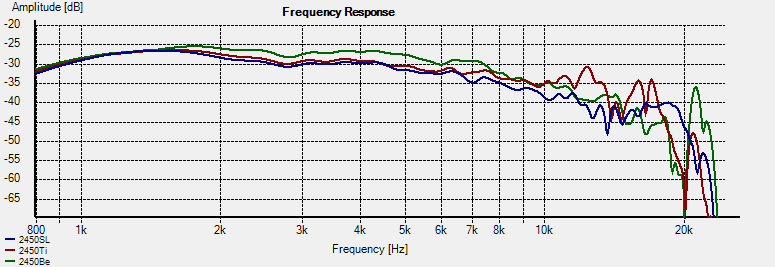
I also have a lot a tweeters extending further past 20khz. I just checked my measurements (on the same systems) and none of them shows that peak at 21khz.
As for the lower distortion, I don't know exactly how much is due to the difference in core (although both cores are neodymium, the 2452 is an "optimized" design, with a much smaller magnet achiving the same efficiency), and how much is due to the difference in diaphragm material. I don't think the 2452 core is supposed to have higher distortion than the 2450SL core...
On the other hand, looking at the tube measurements in theTruextent white paper I don't see that sort of distortion difference between the different materials either. But then these are high SPL measurement, maybe different distortion factors come into play at those SPL...
I would have to make more measurements, but I don't have those 2452 drivers anymore, and no other diaphragm type either...
Maybe it was due to the amp, because my Be diaphragms are 16ohms so I gave them a 3dB boost, so the noise/distortion floor of the amp was rejected that much (see above measurement with resistance, lpad, and autoformer). But then it would have been a 3dB reduction max, whether it is more than 10dB here...
Sure facts about that Be diaphragm are:
- for the same impedance it gives a clear 2-3dB boost throughout the midband thanks to a higher mass breakpoint. That alone is already an achievement.
- it is smooth up to the UHF but rolls off a bit, both because of the use of mylar surrounds with no parasitic resonances
- it has a peak above 20khz that will show on the impulse (and probably CSD)
- the polarity is reversed, contrary to what is said in the doc (same polarity as the JBL diaphragms, which is a good thing for a replacement diaphragm...)
- it is very expensive
- it sounds great, better than anything I have tried so far (quite subjective I confess, but hey...)
(quite subjective I confess, but hey...)
I really think it is a coincidence, and they do not appear at the exact same frequency either.
Here is another older comparison, made on the same 2450SL core, but with 3 different diaphragms: Ti ribbed (red), Be (green), Ti SL (blue).
You can see that the peaks around 21khz are still there for the Ti ribbed and Be, but not for the SL.
I also have a lot a tweeters extending further past 20khz. I just checked my measurements (on the same systems) and none of them shows that peak at 21khz.
As for the lower distortion, I don't know exactly how much is due to the difference in core (although both cores are neodymium, the 2452 is an "optimized" design, with a much smaller magnet achiving the same efficiency), and how much is due to the difference in diaphragm material. I don't think the 2452 core is supposed to have higher distortion than the 2450SL core...
On the other hand, looking at the tube measurements in theTruextent white paper I don't see that sort of distortion difference between the different materials either. But then these are high SPL measurement, maybe different distortion factors come into play at those SPL...
I would have to make more measurements, but I don't have those 2452 drivers anymore, and no other diaphragm type either...
Maybe it was due to the amp, because my Be diaphragms are 16ohms so I gave them a 3dB boost, so the noise/distortion floor of the amp was rejected that much (see above measurement with resistance, lpad, and autoformer). But then it would have been a 3dB reduction max, whether it is more than 10dB here...
Sure facts about that Be diaphragm are:
- for the same impedance it gives a clear 2-3dB boost throughout the midband thanks to a higher mass breakpoint. That alone is already an achievement.
- it is smooth up to the UHF but rolls off a bit, both because of the use of mylar surrounds with no parasitic resonances
- it has a peak above 20khz that will show on the impulse (and probably CSD)
- the polarity is reversed, contrary to what is said in the doc (same polarity as the JBL diaphragms, which is a good thing for a replacement diaphragm...)
- it is very expensive
- it sounds great, better than anything I have tried so far
Last edited:
Radian now have be diaphragms:
We have been working for about a year with the company Materion-True Extend for getting Beryllium material for making diaphragms. At long last we are now producing all the diaphragms for all our compression and coaxial drivers, current product as well as those produced for years.
Anyone got more experience on the difference between aluminum and beryllium diaphragms?
I am pretty darn happy with my aluminum ones.
More10, I am having trouble believing that statement, about aquaplased Ti will sound better than aluminum. I have the means to try it, so we shall see.
I am pretty darn happy with my aluminum ones.
More10, I am having trouble believing that statement, about aquaplased Ti will sound better than aluminum. I have the means to try it, so we shall see.
Last edited:
18_Sound sells a Titanium diaphragm with a nitride coating. The figure shows their example SPL and Impulse plots. Table of metal diaphragm physical properties.
Magnesium diaphragms were popular a few years back.
I have a Beyma CP380 with a low distortion 1" plastic diaphragm. I am still studying the wide variation in plastic diaphragm physical property data.
Magnesium diaphragms were popular a few years back.
I have a Beyma CP380 with a low distortion 1" plastic diaphragm. I am still studying the wide variation in plastic diaphragm physical property data.
Attachments
I see most of this discussion was focused on the breakup above some very high frequency, like 8-10k. It begs the question about using the less expensive diaphragms in combination with a JBL 2405 tweeter to offload the breakup to a driver designed to carry that load.
Thoughts?
Thoughts?
I see most of this discussion was focused on the breakup above some very high frequency, like 8-10k. It begs the question about using the less expensive diaphragms in combination with a JBL 2405 tweeter to offload the breakup to a driver designed to carry that load.
Thoughts?
I prefer 1st or 2nd order XO on horns. So you will probably hear some of that breakup even with a supertweeter. But breakup can be nice. What I would describe as detail and color, some would call typical nasty aluminum diaphragm breakup. I would love to put the Trueextent against aluminum diaphragms in a A/B test some day.
Well I've collected now quite the stable of various compression drivers to personally test the quality of the sound with real music, not test tones. I have a 1" JBL 2425 with both the stock JBL Al diaphragm and the Radian Al Diaphragm. I also have a 2" JBL 2446 with a stock JBL Ti ribbed diaphragm and a TAD 4001 with a stock TAD Be diaphragm. I'm going to use these with one of my favorite horns (JBL 4380) to try to keep something constant in the comparison.
My comparison will be using these in a fully active system (DSP) from 1khz to 10khz with 24db slopes.
I'll report back with my impressions.
My comparison will be using these in a fully active system (DSP) from 1khz to 10khz with 24db slopes.
I'll report back with my impressions.
Last edited:
I would recommend comparing one speaker agains another (with a differenc driver in each) in order to do a proper AB test. It's difficult to remember small difference when time has passed and one can easily be influenced in several ways.
The use of different EQ is can also attribute a lot. In reality, a test like this is very difficult to run in a fair way.
The use of different EQ is can also attribute a lot. In reality, a test like this is very difficult to run in a fair way.
What's a JBL 4380 horn?. Last one I saw was a rare colinear line array
http://www.jblpro.com/pub/obsolete/4375_4380.pdf
http://www.jblpro.com/pub/obsolete/4375_4380.pdf
What's a JBL 4380 horn?. Last one I saw was a rare colinear line array
http://www.jblpro.com/pub/obsolete/4375_4380.pdf
Duh fat fingers typo syndrome.... Sorry its a 2380. There is also a 2380A, but which is similar. Here is a picture of a 2380.
An externally hosted image should be here but it was not working when we last tested it.
I would recommend comparing one speaker agains another (with a differenc driver in each) in order to do a proper AB test. It's difficult to remember small difference when time has passed and one can easily be influenced in several ways.
The use of different EQ is can also attribute a lot. In reality, a test like this is very difficult to run in a fair way.
thank you and I agree. That is exactly what I'll be doing. Thanks for pointing it out as others might not have heard that before and testing can be very problematic if you rely on your memory of sounds.
Duh fat fingers typo syndrome.... Sorry its a 2380. There is also a 2380A, but which is similar. Here is a picture of a 2380.
An externally hosted image should be here but it was not working when we last tested it.
Hmmm, that horn has a 'nasty' old style hard diffraction slot close to its throat. That may well mask many of the more subtle differences...
Marco
I've got JBL 2440 drivers with JBL D16R2445 titanium diaphragms installed - widely considered to be the least desirable diaphragm choice in this driver, but they sound quite good. I am considering the purchase of a set of Radian 1245-16 at some point as a potential upgrade. The Truextents are beyond reach for now anyway..
Hi -
How is the high end (above 10khz) with that combo? I've never been able to determine from reading if the 2440 and 2441 differed just because of their diaphragm design or whether there was a phase plug difference also. I've got a couple 2440's needing new diaphragms that I might consider truextent for if they can push the high end at least to a solid 15 khz.
Well I've collected now quite the stable of various compression drivers to personally test the quality of the sound with real music, not test tones. I have a 1" JBL 2425 with both the stock JBL Al diaphragm and the Radian Al Diaphragm. I also have a 2" JBL 2446 with a stock JBL Ti ribbed diaphragm and a TAD 4001 with a stock TAD Be diaphragm. I'm going to use these with one of my favorite horns (JBL 4380) to try to keep something constant in the comparison.
My comparison will be using these in a fully active system (DSP) from 1khz to 10khz with 24db slopes.
I'll report back with my impressions.
Any update?
- Status
- This old topic is closed. If you want to reopen this topic, contact a moderator using the "Report Post" button.
- Home
- Loudspeakers
- Multi-Way
- Truextent Beryllium replacement diaphragms
